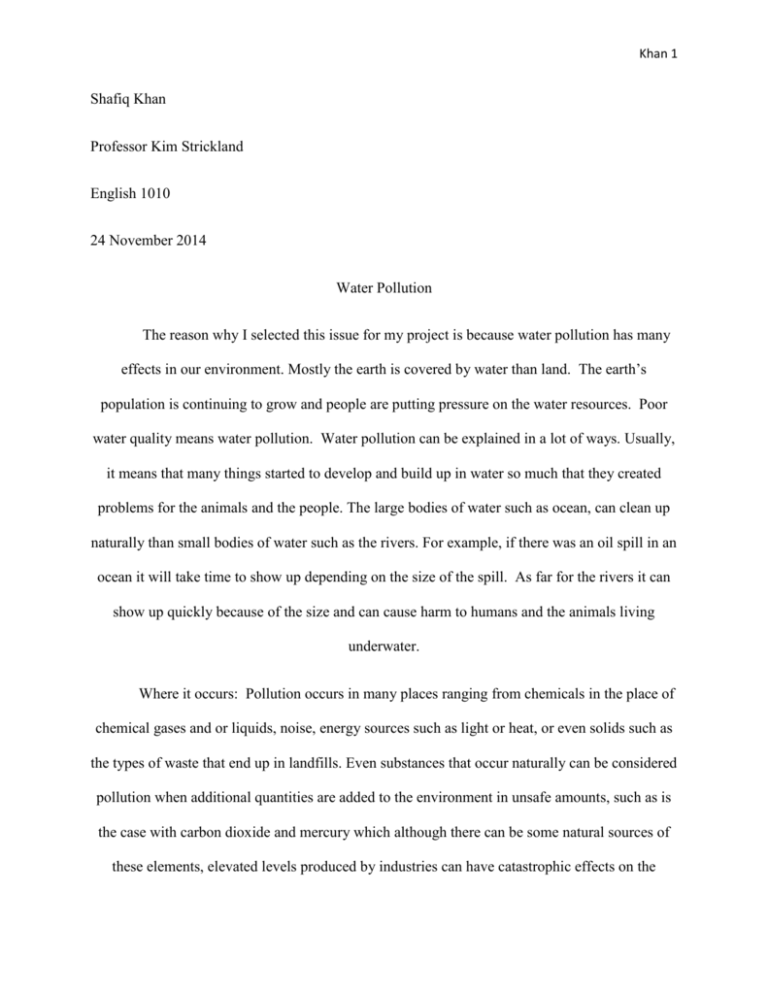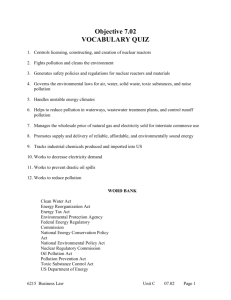File
advertisement

Khan 1 Shafiq Khan Professor Kim Strickland English 1010 24 November 2014 Water Pollution The reason why I selected this issue for my project is because water pollution has many effects in our environment. Mostly the earth is covered by water than land. The earth’s population is continuing to grow and people are putting pressure on the water resources. Poor water quality means water pollution. Water pollution can be explained in a lot of ways. Usually, it means that many things started to develop and build up in water so much that they created problems for the animals and the people. The large bodies of water such as ocean, can clean up naturally than small bodies of water such as the rivers. For example, if there was an oil spill in an ocean it will take time to show up depending on the size of the spill. As far for the rivers it can show up quickly because of the size and can cause harm to humans and the animals living underwater. Where it occurs: Pollution occurs in many places ranging from chemicals in the place of chemical gases and or liquids, noise, energy sources such as light or heat, or even solids such as the types of waste that end up in landfills. Even substances that occur naturally can be considered pollution when additional quantities are added to the environment in unsafe amounts, such as is the case with carbon dioxide and mercury which although there can be some natural sources of these elements, elevated levels produced by industries can have catastrophic effects on the Khan 1 environment and all forms of life including humans. The causes of this can be with are sewage and water waste. Scientists say that: The sewage and waste water that is produced by each household is chemically treated and released in to sea with fresh water. The sewage water carries harmful bacteria and chemicals that can cause serious health problems. Pathogens are known as a common water pollutant; the sewers of cities house several pathogens and with diseases. Microorganisms in water are known to be causes of some very deadly diseases and become the breeding grounds for other creatures that act like carriers. These carriers inflict these diseases via various forms of contact onto an individual. A very common example of this process would be Malaria. This can cause many problems such as disease if we drink water that is and have been polluted. The scientists say that Chemical fertilizers and pesticides are used by farmers to protect crops from insects and bacteria’s. They are useful for the plants growth. However, when these chemicals are mixed up with water produce harmful for plants and animals. Also, when it rains, the chemicals mixes up with rainwater and flow down into rivers and canals which pose serious damages for aquatic animals. Organic factors include volatile organic compounds, fuels, waste from trees, plants etc. Inorganic factors include ammonia, chemical waste from factories, discarded cosmetics etc. The water that travels via fields is usually contaminated with all forms of waste inclusive of fertilizers that it swept along the way. This infected water makes its way to our water bodies and sometimes to the seas endangering the flora, fauna and humans that use it along its path. Khan 1 The current scenario has led to a consciousness about water preservation and efforts are being made on several levels to redeem our water resources. Industries and factory set-ups are restricted from contaminating the water bodies and are advised to treat their contaminated waste through filtration methods. People are investing in rain water harvesting projects to collect rainwater and preserve it in wells below ground level. Water Pollution is common, and is an area of high alert. Water needs to be preserved and respected today, for us to live a tomorrow. The scientist said that Nuclear energy is produced using nuclear fission or fusion. The element that is used in production of nuclear energy is Uranium which is highly toxic chemical. The nuclear waste that is produced by radioactive material needs to be disposed of to prevent any nuclear accident. Nuclear waste can have serious environmental hazards if not disposed of properly. Few major accidents have already taken place in Russia and Japan. Based on the research I have learned a lot and how really water pollution can be a major problem to animals and humans. Based on the sources I agree that mostly it affects animals, humans, and plants. But I never knew it and disagree that it created global warming and it affected the nutrients. The most interesting and surprising thing I discovered is that invasive species are animals or plants from one region that have been introduced into a different ecosystem where they do not belong. As far for water pollution there is nothing we can do Works cited and reflection: Khan 1 Dalgleish, Sharon. “Saving water.” Philadelphia. Chelsea House Publishers, 8 Nov. 2009. Web. 16 May. 2010. In this brief annotation is that Dalgleish talks about how water pollution can be a big problem for us and how water pollution can cause bacteria from the water we drink if we don’t take care of it talks about putting sign boards on poles and streets saying no littering allowed, to avoid water pollution. Haulzan, Ned. “Water Pollution.” Articles. BlogSpot, 6 Apr. 2012. Web. 27 Aug. 2012. For this brief annotation is that Haulzan talks about the interesting things and facts about water pollution that my impact the environment and the animals in underwater might get extinct as well. Jakab, Cheryl. “Clean air and water.” North Mankato. MN: Smart Apple Media, 8 May. 2008. Web. 16 Oct. 2007. For the brief annotation on this source is that Cheryl talks a lot more about the pollution and causes about how these will effect the environment. For this source I learned how it can affect are climate. Stefanow, Jennifer. “Polluted waters.” Chicago, Ill. Raintree, 4 Sept. 2004. Web. 12 Mar. 2006. Khan 1 In this brief annotation is that Stefanow talks more about the water pollution issue and can help others avoid it as well because of the bacteria that can grow in water which is not good for the animals and for us. Reflection: As my reflection is that all these sources are useful for my paper because each of the source have a different topic and story about water pollution. When combing them I will come up with a great issue paper. Works Cited: Dalgleish, Sharon. “Saving water.” Philadelphia. Chelsea House Publishers, 8 Nov. 2009. Web. 16 May. 2010. Haulzan, Ned. “Water Pollution.” Articles. BlogSpot, 6 Apr. 2012. Web. 27 Aug. 2012. Khan 1 Jakab, Cheryl. “Clean air and water.” North Mankato. MN: Smart Apple Media, 8 May. 2008. Web. 16 Oct. 2007. Stefanow, Jennifer. “Polluted waters.” Chicago, Ill. Raintree, 4 Sept. 2004. Web. 12 Mar. 2006. Gay, Kathlyn. Water pollution. New York. F. Watts, 23 Jan. 1990. Web. 27 Apr. 2010. David, Michael, David, and Caroline. "Water Pollution." ThinkQuest. Oracle Foundation, 7 Feb. 1999. Web. 15 Nov. 2012. Khan 1 Copeland, Blythe. "Top 5 Ways Water Gets Polluted." TreeHugger. MNN Holdings, 15 June 2009. Web. 28 Nov. 2012. Rand, Ary. “Natural Resources.” Articles. BlogSpot, 14 June. 2014. Web. 23 Oct. 2014. Bowden, Rob. Water supply: our impact on the planet. Raintree Steck, 15 May. 2007. Web. 17 June. 2009. Khan 1






